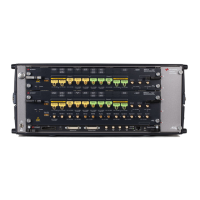36 Keysight M8070A Programming Guide
2 Recommended Programming Techniques
Working with Patterns
Patterns can be accessed with a program and are stored in three different
areas:
1 Local to current setting (“current:”)
2 Shared between settings (“shared:”)
3 Factory supplied standard patterns (“factory:”). These patterns are read
only and cannot be modified.
Below these root nodes is a folder structure using ‘/’ as a separation
character. So a complete pattern name might be something like
“factory:SATA/LTDP-short”.
Patterns consist of a sequence of symbols. A symbol has a coding:
1 Binary (“Bit”)
2 8b10b (“B8B10”)
3 128/130 (“B128B130”)
4 128/132 (“B128B132”)
A symbol can have additional attributes to modify behavior. All symbols
support:
1 Mask: this attribute affects DataIn locations only. It specifies if the
symbol is actually compared or masked (excluded from compare).
2 Squelch: this attribute affects DataOut locations only. If this attribute is
1, a squelch (out of band) level is used.
In addition, there are coding specific attributes, to control aspects of the
coding such as bypassing or using a scrambler. Refer to
:DATA:PATTern:IDATa[?] on page 474 for more information.
The :DATA:PATTern:USE SCPI command is used to specify the patterns
and attributes. Refer to :DATA:PATTern:USE[?] on page 473 for details on
how to specify a pattern and set up its parameters. The parameters include
the pattern name, number of symbols, symbol coding (optional), mask
(optional) and squelch (optional).

